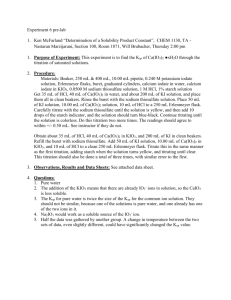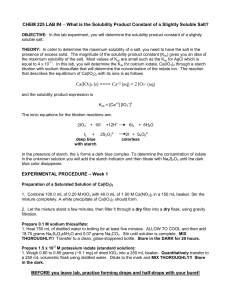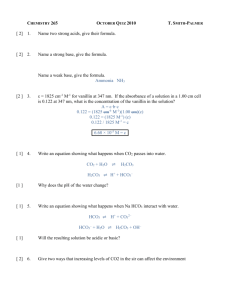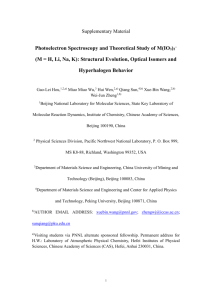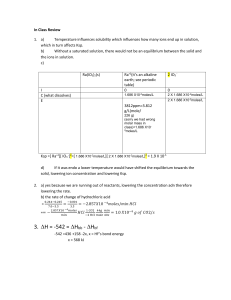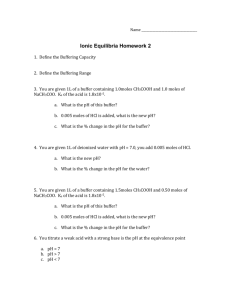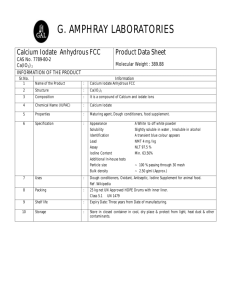Molar Mass of a Volatile Liquid
advertisement
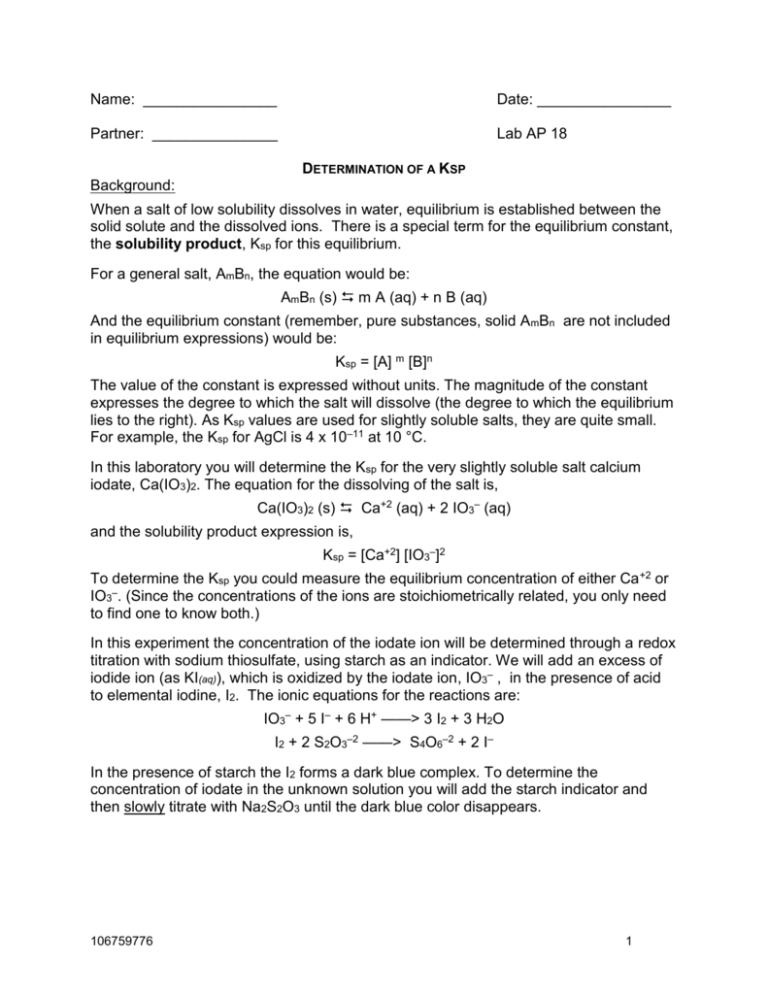
Name: ________________ Date: ________________ Partner: _______________ Lab AP 18 DETERMINATION OF A KSP Background: When a salt of low solubility dissolves in water, equilibrium is established between the solid solute and the dissolved ions. There is a special term for the equilibrium constant, the solubility product, Ksp for this equilibrium. For a general salt, AmBn, the equation would be: AmBn (s) m A (aq) + n B (aq) And the equilibrium constant (remember, pure substances, solid AmBn are not included in equilibrium expressions) would be: Ksp = [A] m [B]n The value of the constant is expressed without units. The magnitude of the constant expresses the degree to which the salt will dissolve (the degree to which the equilibrium lies to the right). As Ksp values are used for slightly soluble salts, they are quite small. For example, the Ksp for AgCl is 4 x 10–11 at 10 °C. In this laboratory you will determine the Ksp for the very slightly soluble salt calcium iodate, Ca(IO3)2. The equation for the dissolving of the salt is, Ca(IO3)2 (s) Ca+2 (aq) + 2 IO3– (aq) and the solubility product expression is, Ksp = [Ca+2] [IO3–]2 To determine the Ksp you could measure the equilibrium concentration of either Ca +2 or IO3–. (Since the concentrations of the ions are stoichiometrically related, you only need to find one to know both.) In this experiment the concentration of the iodate ion will be determined through a redox titration with sodium thiosulfate, using starch as an indicator. We will add an excess of iodide ion (as KI(aq)), which is oxidized by the iodate ion, IO3– , in the presence of acid to elemental iodine, I2. The ionic equations for the reactions are: IO3– + 5 I– + 6 H+ ——> 3 I2 + 3 H2O I2 + 2 S2O3–2 ——> S4O6–2 + 2 I– In the presence of starch the I2 forms a dark blue complex. To determine the concentration of iodate in the unknown solution you will add the starch indicator and then slowly titrate with Na2S2O3 until the dark blue color disappears. 106759776 1 Safety: Wear safety goggles at all times. Treat all unknown chemicals as hazardous. If case of skin contact, wash the affected area immediately Supplies: Materials: NaIO3 1.0M Ca(NO3)2 solution 0.10M KNO3 0.05M Na2S2O3 KI Starch solution Equipment: Magnetic stirrer and stir bar 250 mL flask (2) 125 mL flask (several) 50 or 100 mL graduated cylinder Filter funnel and filter paper Buret 10 mL pipet Procedure Part I — Preparation of a Saturated Solution of Ca(IO3)2 Note: While you have idle time during Part I, start setting up for your titration, Part II. 1. Mass 3.96 g of NaIO3 in a weighing boat and transfer the salt to a 250 mL Erlenmeyer flask. Use a graduated cylinder to add 100 mL of distilled water. Add a magnetic stir bar stir until the NaIO3 is completely dissolved. 2. Using a graduated cylinder, slowly add 20.0 mL 0.50M Ca(NO3)2 solution while stirring. Stir the mixture completely for 5 minutes. A white precipitate of Ca(IO 3)2 should form. 3. Let the mixture stand a few minutes, then decant off and discard the supernatant liquid. (It’s okay to lose a little solid when decanting. At this stage we are just trying to have some clean solid.) Obtain about 200 mL of 0.10M KNO 3 in a clean flask. Wash the solid by adding 30 mL of 0.10M KNO3 and stirring thoroughly for 5 minutes. Repeat the wash process for a total of three washes. 4. Add 100 mL of the 0.1M KNO3 and stir for another 5 minutes. There must be solid left in the flask at this time. (At this stage we are trying to establish the equilibrium. We now want the solution. The solid is not important, only that some exists.) 5. Set up a filter funnel with filter paper and decant/filter the suspension into a clean dry flask 125 mL Erlenmeyer flask. Most of the solid should remain in the original flask. Do not wash the solid. Save the filtrate (liquid) for the next step. 106759776 2 Part II — Determination of [IO3–] in the Saturated Solution of Ca(IO3)2 1. Set up a buret and fill it with the standardized solution of approximately 0.05M Na2S2O3. Be sure to record the actual concentration in your laboratory notebook. 2. Pipet 10.0 mL of the filtrate from Part I, above, into a clean Erlenmeyer flask. Add about 20 mL of distilled water to the flask. 3. Weigh about 2 g of solid KI (a large excess) in a weigh boat and transfer into the solution. Add 20 drops of 2 M HCl and mix thoroughly. The solution should take on a brown color. 4. Titrate the mixture with the Na2S2O3 until the brown color changes to yellow. 5. When the solution is a light yellow, add several drops of starch to the solution, enough to turn the solution black. 6. Continue titrating with the Na2S2O3 until the blue/black color just disappears. 7. Repeat the titration a second time. If time permits, complete a third trial. 106759776 3 Calculations 1. Using the known concentration of sodium thiosulfate, calculate the iodate concentration, [IO3–], in the filtrate. (Hint: There’s some stoichiometry involved here. Use the volume and concentration of sodium thiosulfate to calculate moles of S2O3-2. Then use the stoichiometry in the equations to determine the moles of I2 consumed. Then use the stoichiometry of the reaction to determine the moles of IO3- used to produce these moles of I2. This can all be done with one dimensional analysis string or as separate steps. Either way, clearly show your work. Finally, using the aliquot volume of your filtrate, calculate the concentration of the iodate ions.) 2. For every IO3- ion, how many Ca+2 ions are in solution? From the [IO3–], calculate the concentration of [Ca+2]. Write out the Ksp expression and then determine the Ksp of Ca(IO3)2. Questions 1. Calculate the moles of Ca+2 from the Ca(NO3)2 used in the experiment. Calculate the moles of IO3- from the NaIO3 used. Based on these values, calculate he mass of Ca(IO3)2 produced in the lab. 2. Calculate the theoretical concentration if iodate, [IO3–], from the literature value of Ksp. 3. Why do you think we need to go through several washings prior to taking the aliquot for the [IO3-] determinations? (Hint: how hard is it to hit a pH of exactly 7.00 when doing a titration?) Error analysis 1. Look up the accepted value of the Ksp and compare your results with the expected value. 2. Calculate the experimental error using both the value for Ksp and the value you calculated for the theoretical concentration of IO3- in #2 above. Which do you think is a better representation of the error in the lab? Explain why! 3. Comment on sources of error and possible ways to improve the lab. Report. Don’t forget you purpose and conclusions demonstrating the principals involved in the lab. 106759776 4 Notes to self: The washing of the solid and preparation of the saturated solution took longer than expected. This could be done prior to the lab to allow more time for multiple titrations. Perhaps do it as a demo during the prior day’s lecture and prepare enough for the entire class. The sodium thiosulfate seems to be of high purity. Standardization of the solution yielded exactly the concentration calculated from the mass and volume. Don’t bother standardizing in the future. 106759776 5
